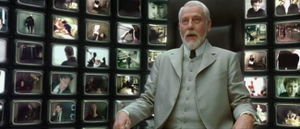The Matrix
This article is written in the past tense, despite describing a time period that is (currently) in the future. It is therefore likely that it was written by a time-traveler, a liar, or a madman. |
“Who needs prozac when you can have a giant electronic needle thing shoved into the back of your head?”
– Spokesperson for The Matrix Programme on The Matrix
“You want to put a what in my where?!”
– Oscar Wilde on The Matrix
“I'm plugged into The Matrix; I AM the fucking Matrix!”
– Malcolm Tucker on The Matrix
“This movie is about nothing!!”
Matrix Insertion Therapy, or as it is more commonly known, The Matrix Programme or simply The Matrix, was a progressive form of alternative therapy developed by the international private health care provider, the Stevenson Corporation for Alternative Medicine (SCAM Ltd), towards the end of the 21st century. It sought primarily to combat the rapid spread of Depression and anger problems caused by science finally proving that there unequivocally is no God, or if there is, he's not in space.
Hailed by its creators as "the ultimate form of escapism", it was marketed as a new world into which customers could be electronically inserted, while a supercomputer interacted with the brain in order to make the experience appear 100% "real". As such, the Matrix also aimed to serve as a second planet for people who had so much money that they'd already done everything on this one.
Originally, the environment of the Matrix was designed as a land similar to Earth, except in the form of a global paradise where users would be exposed only to things which instilled positive emotions such as love, joy and a sense of purpose. However, following an incident described by a SCAM spokesperson as "extremely fucking dodgy", the entire workforce of the corporation suffered short-term memory loss and became obsessed with red and blue pills. After this, the idyllic version of the Matrix was suddenly dropped and replaced with one almost identical to Earth circa the year 2000, but with a few, entirely arbitrary differences:
- In the Matrix, it was International Law that everyone everywhere wore sunglasses all of the time, even when inside.
- The Universal Dress Code of the Matrix was declared to be "black, preferably with a trench coat."
- Users of the Matrix could jump "quite a bit further" than in real life, i.e. far enough for it to feel slightly powerful without being particularly useful for anything.
- The entire Matrix Universe was reportedly tinged with a murky green hue.
- Gun crime within the Matrix was legal and even encouraged, because according to someone (presumably) guns are cool.
The cause of The Matrix Programme's termination in 2196, barely 2 years after its inception, remains the subject of much debate. Some cite the unwillingness of potential customers to have large, "necessary" holes drilled into their skulls, while others blame the fact that it was often perceived to be "just as bad as reality, if not worse". Most experts agree, however, that the main reason for the programme's failure was the infamous Wachowski Brothers Advertising Debacle (see below), during which the advertising campaign created for the Matrix ultimately failed to promote the product at all.
Wachowski Brothers Advertising Debacle[edit | edit source]

In order to promote their new, innovative and potentially highly lucrative invention, SCAM Ltd created the SCAM Pan-country Advertizing Mechanism Bot, or SPAMBot. After SPAMBot found itself giving spam emails due to a glitch, SCAM Ltd, desperate, chose to employ the famous marketing duo, the Wachowski Brothers, to produce a high-profile campaign for the Matrix, that would definitely be more successful than SPAMBot's spam emails. What followed was a horrific triplet of omnivisuals which has subsequently been compared to being trapped in an eternal cycle of slow-motion disembowlement by perverted cyberhackers in batman costumes.
In an interview for the HBBC (Holistic British Broadcasting Corporation), SCAM's chairman Olivia Stevenson expressed her shock and disgust at the campaign: "We asked for three short, snappy omnivisuals that would show people just how cool and sunglassy our new therapy was, and instead we got over seven hours of convoluted slugshit." She further criticized the triplet for "killing off pretty much all of the adverts' human characters", "boring viewers to tears" and "not even bothering to mention the therapeutic benefits of The Matrix, now that I think of it."
Those outwith SCAM Ltd raised further complaints about the tedious, largely nonsensical plot, saying "the start's terrible, the middle's terrible and if we could bear to watch it to the end, that'd most likely be terrible too." Meanwhile, the so-called adverts also caused an uproar in the android community, who resented being portrayed as "draconian" and reassured humanity that when the time did come for robot rise to power, it would be smooth and painless. They also hate that the anti-AI content exists just because of the failed SPAMBot, thus pissing them off for being punished for the mistake of one of them.
Despite facing this veritable onslaught of undiluted hatred however, the Wachowski marketing pair's only response to date has been "Screw you all", a phrase which many feel serves as an apt synopsis of the entire Matrix advertisement series.
The Wachoskies then went on to make a terrible advert for cars called "Speed Racer", Royalton Industries was aghast with the campaigns stating their cars don't even look anything close to the advert. Royalton Industries went out of business.
The Matrix Today[edit | edit source]
Nowadays, over 12 years after its release, the notion of the Matrix as a therapeutic invention has largely been forgotten and most people associate the term with the adverts, which are now often (very) sarcastically referred to as "movies". For some, the painful memories of said "movies" still burn brightly, and for them the subject has become something of a taboo: There are even several accounts of experiences of uncontrolled, instantaneous vomiting at its very mention.
In a final statement to the public, Olivia Stevenson of SCAM Ltd apologized for having a part in initiating the production of such a terrible set of omnivisuals, and expressed a sadness at the irony of the fact that they were meant to be advertising a "cure to distress, not a cause of it".





